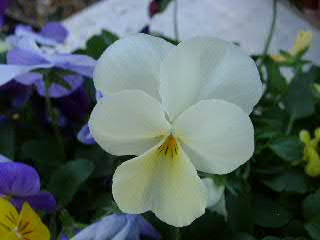


This week was a roller coaster of activity.After an early spring here, Winter made a icy come back. I went deep into the woods where a huge Bur Oak stands on the highest point of the farm. Before my mother died,she always said she wanted her ashes placed under a tree that would feed wild life and be of some good to the Earth. When she did finally pass on, I felt compelled to honor her wishes,so the most magical tree ,on the highest point became her final resting place. At first I wasn't sure what to do, I had the ashes...which are surprisingly heavy-pulverized bone,really bone meal. Then it came to me... I'd use her remains as bulb food and kill two birds with one stone-(no pun intended-well a little.) I made a lasso out of some twine and encircled the massive 200+ year old tree. Scoring a perfect circle in the ground gave me the exact template needed for a myriad of spring bulbs as well as a late summer display of Lycoris Squamigera, what we call Naked Ladies here in the Midwest. There is something so beautiful about emerging from the wooded path and seeing this special tribute to an amazing woman. This time of year is all about Iris Reticulata, different Muscari, miniature Daffodils-including some antique Narcissus Poeticus bulbs rescued from an abandoned farm stead. Marie was a code breaker during WW Two as well as an accomplished poet, and she had a fetish for spring ephemerals. Add to this antique Woodstock Hyacinths,Scillas,Crocus and several other varieties of bulbs that settled in their new home with the nutritious food my mother's ashes provided. Her favorite color combination was bright pink and apple green. The August show of Lycoris in a perfect ring would have pleased her to no end. I took this picture before the snow and Ice came this weekend,the bulbs will be fine-maybe they'll last that much longer! This week also brought several new members to the farm family. Four downy Americana chicks came home to join the flock...eventually. Those older hens would kill the sweet chicks if I tried to introduce them now, they get to be babied for several months before that can happen. I also went to a bird fair and found a wonderful pair of Red Factor Canaries, the cock is tomato soup orange (thor) and the hen is called a red-bronze (Coco) yes- as in Chanel. I'll eventually have them at my store Bergamot and Ivy, in a great bee hive flight cage. For right now-their getting acquainted with each other. The cock must serenade the hen and feed her special treats before she will accept him. some other winged friends came back this last week-every year I have a family of Eastern Phoebes build their nest on a light fixture hanging in the porch...like clockwork they've already refreshed the nest with green mosses. To me, the Phoebes , Orchard Orioles and Ruby throats -coming in about fifteen more days- are the true harbingers of Spring.




































